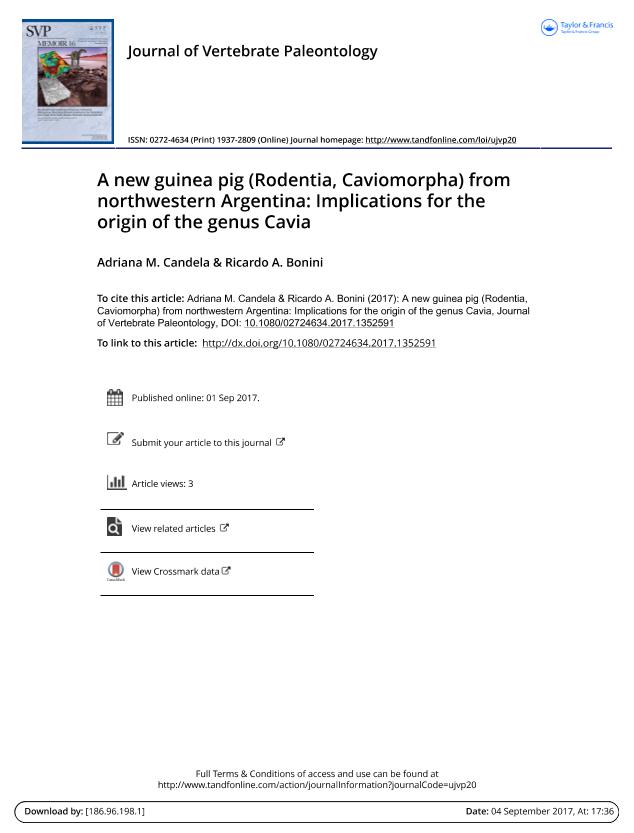Mostrar el registro sencillo del ítem
dc.contributor.author
Candela, Adriana Magdalena

dc.contributor.author
Bonini, Ricardo Adolfo

dc.date.available
2018-09-07T16:18:43Z
dc.date.issued
2017-07
dc.identifier.citation
Candela, Adriana Magdalena; Bonini, Ricardo Adolfo; A new guinea pig (Rodentia, Caviomorpha) from northwestern Argentina: implications for the origin of the genus Cavia; Society of Vertebrate Paleontology; Journal of Vertebrate Paleontology; 37; 4; 7-2017
dc.identifier.issn
0272-4634
dc.identifier.uri
http://hdl.handle.net/11336/58708
dc.description.abstract
We describe a new caviomorph rodent, Cavia cabrerai, sp. nov. (Caviidae, Caviinae), from the upper levels of Andalhuala Formation (San Fernando Norte locality, Catamarca Province, northwestern Argentina), which represents the oldest fossil record of the genus. The new species differs from extant and extinct species of Cavia by a unique combination of characters: large size, proportionally anteroposteriorly elongated molars, slightly anteroposteriorly compressed prisms, relatively shallow primary lingual flexids, abundant cement in the lingual flexids, and anterolingual widening of the second crests of cheek teeth. A phylogenetic analysis indicates that Cavia cabrerai, sp. nov., is the sister taxon of extant Cavia species and displays dental characters more plesiomorphic than the latter. Some characters of C. cabrerai, sp. nov., namely, compression of prisms and depth of flexids, are morphologically intermediate between the related extinct Caviinae Palaeocavia and the extant species of Cavia. An ash bed dated at 4.72 ± 0.08 Ma that overlies the fossiliferous level of the new material supports the presence of Cavia close to the Miocene-Pliocene boundary. The origin of Cavia may have been triggered by the expansion of relatively open and arid environments that arose near the Miocene-Pliocene boundary.http://zoobank.org/urn:lsid:zoobank.org:pub:3A6E6666-1FBE-4C6E-95CA-4B33927A414D SUPPLEMENTAL DATA—Supplemental materials are available for this article for free at www.tandfonline.com/UJVP Citation for this article: Candela, A. M., and R. A. Bonini. 2017. A new guinea pig (Rodentia, Caviomorpha) from northwestern Argentina: Implications for the origin of the genus Cavia.
dc.format
application/pdf
dc.language.iso
eng
dc.publisher
Society of Vertebrate Paleontology

dc.rights
info:eu-repo/semantics/openAccess
dc.rights.uri
https://creativecommons.org/licenses/by-nc-sa/2.5/ar/
dc.subject
Caviidae
dc.subject
Neógeno
dc.subject
Catamarca
dc.subject
Dated
dc.subject.classification
Paleontología

dc.subject.classification
Ciencias de la Tierra y relacionadas con el Medio Ambiente

dc.subject.classification
CIENCIAS NATURALES Y EXACTAS

dc.title
A new guinea pig (Rodentia, Caviomorpha) from northwestern Argentina: implications for the origin of the genus Cavia
dc.type
info:eu-repo/semantics/article
dc.type
info:ar-repo/semantics/artículo
dc.type
info:eu-repo/semantics/publishedVersion
dc.date.updated
2018-09-07T13:51:44Z
dc.identifier.eissn
1937-2809
dc.journal.volume
37
dc.journal.number
4
dc.journal.pais
Estados Unidos

dc.journal.ciudad
Lawrence
dc.description.fil
Fil: Candela, Adriana Magdalena. Universidad Nacional de La Plata. Facultad de Ciencias Naturales y Museo. División Paleontología Vertebrados; Argentina. Consejo Nacional de Investigaciones Científicas y Técnicas; Argentina
dc.description.fil
Fil: Bonini, Ricardo Adolfo. Consejo Nacional de Investigaciones Científicas y Técnicas. Centro Científico Tecnológico Conicet - Tandil. Investigaciones Arqueológicas y Paleontológicas del Cuaternario Pampeano. Universidad Nacional del Centro de la Provincia de Buenos Aires. Investigaciones Arqueológicas y Paleontológicas del Cuaternario Pampeano; Argentina
dc.journal.title
Journal of Vertebrate Paleontology

dc.relation.alternativeid
info:eu-repo/semantics/altIdentifier/doi/http://dx.doi.org/10.1080/02724634.2017.1352591
dc.relation.alternativeid
info:eu-repo/semantics/altIdentifier/url/https://www.tandfonline.com/doi/abs/10.1080/02724634.2017.1352591
Archivos asociados
